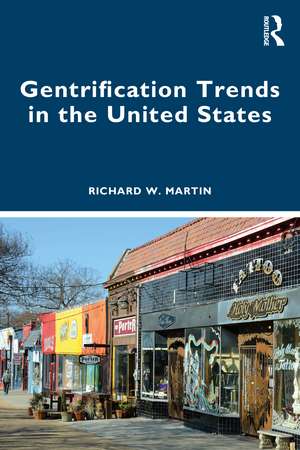Gentrification Trends in the United States
Autor Richard Martinen Limba Engleză Paperback – 18 aug 2023
- Has gentrification become more common over time?
- Which cities have experienced the most gentrification?
- Is gentrification widespread, or does it tend to be concentrated in a small number of cities?
- Has the nature of gentrification changed over time?
| Toate formatele și edițiile | Preț | Express |
|---|---|---|
| Paperback (1) | 303.94 lei 6-8 săpt. | |
| CRC Press – 18 aug 2023 | 303.94 lei 6-8 săpt. | |
| Hardback (1) | 697.53 lei 6-8 săpt. | |
| CRC Press – 18 aug 2023 | 697.53 lei 6-8 săpt. |
Preț: 303.94 lei
Nou
Puncte Express: 456
Preț estimativ în valută:
58.16€ • 60.72$ • 48.13£
58.16€ • 60.72$ • 48.13£
Carte tipărită la comandă
Livrare economică 04-18 aprilie
Preluare comenzi: 021 569.72.76
Specificații
ISBN-13: 9781032107042
ISBN-10: 1032107049
Pagini: 150
Ilustrații: 47 Tables, black and white
Dimensiuni: 156 x 234 x 11 mm
Greutate: 0.46 kg
Ediția:1
Editura: CRC Press
Colecția Routledge
ISBN-10: 1032107049
Pagini: 150
Ilustrații: 47 Tables, black and white
Dimensiuni: 156 x 234 x 11 mm
Greutate: 0.46 kg
Ediția:1
Editura: CRC Press
Colecția Routledge
Public țintă
Postgraduate and Undergraduate AdvancedNotă biografică
Richard W. Martin, PhD, is Associate Professor of Real Estate at the University of Georgia’s Terry College of Business. He is the co-author, with Raphael Bostic, of the landmark paper, “Black Homeowners as a Gentrifying Force.”
Cuprins
1. Introduction. 2. Using Quantitative Methods to Identify Gentrifying Neighborhoods: A Survey. 3. Metropolitan and Central City Trends in Income, Education, and Occupation. 4. Income Gentrification in U.S. Cities, 1970–2010. 5. Educational Gentrification in U.S. Cities, 1970–2010. 6. Occupational Gentrification in U.S. Cities 1970–2010. 7. The Varieties of Gentrification in U.S. Cities, 1970–2010. 8. Conclusion.
Descriere
Gentrification Trends in the United States is the first book to quantify the changes that take place when a neighborhood’s income level, educational attainment, or occupational makeup outpace the city as a whole—the much-debated yet poorly understood phenomenon of gentrification.













